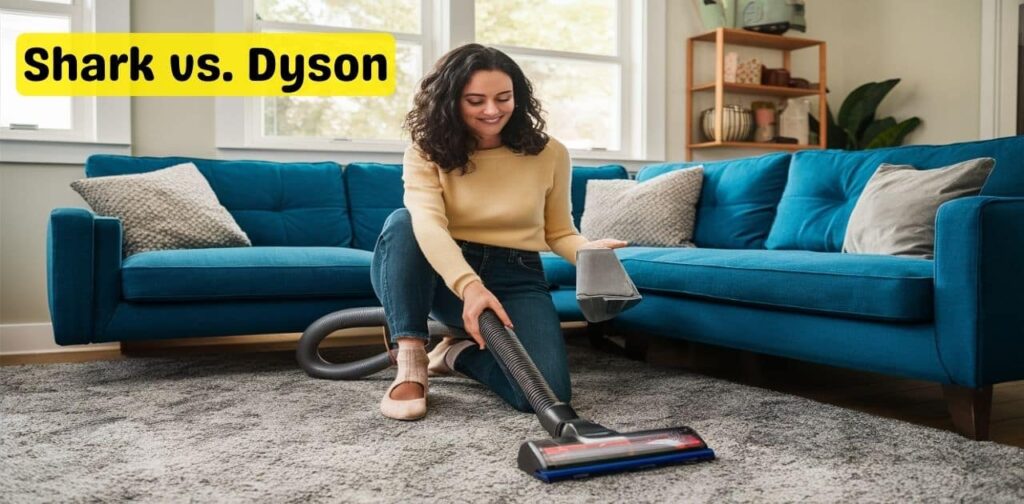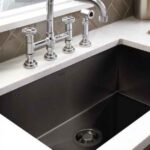Battling endless dust bunnies and pet hair tumbleweeds? Don’t worry, you’re not alone. Every homeowner knows the struggle to keep floors and carpets free from dirt, debris, and whatever else life throws at you. That’s why investing in a high-quality vacuum cleaner is crucial for winning the war on grime.
Speaking of quality vacuums, two iconic brands constantly duke it out for cleaning supremacy: Shark and Dyson. Both offer innovative cyclonic suction technology and a wide range of models to tackle any mess. But which reigns supreme when put to the ultimate vacuum test?
In this no-holds-barred Shark vs. Dyson showdown, we’ll deep-dive into the pros, cons, and unique features of each brand. From suction power to maneuverability to long-term value, we’ll leave no vent unexplored. By the end, you’ll have all the ammunition you need to make an informed decision that’ll keep your floors sparkling for years to come.
Let’s get vacuuming!
Humble Beginnings: A Bit About Shark and Dyson
Before we dive into the nitty-gritty details, let’s take a quick look at the origin stories behind these vacuum titans.

Shark
Shark traces its roots back almost a century to humble beginnings in the European sewing machine market. But it wasn’t until 1995 that the brand took its first leap into vacuum innovation with the invention of the Shark vacuum cleaner by Mark Rosenzweig.
Shark Based in the US, SharkNinja (the parent company) has continuously pushed the envelope with its signature cyclonic, bagless designs ever since.
Dyson
On the other hand, Dyson is the brainchild of UK inventor James Dyson, who took inspiration from an frustrating experience with a vacuum that just wouldn’t cut it back in 1979. Dyson’s “aha” moment was realizing that the sawmill-inspired cyclonic technology could be adapted to separate dust and debris without losing suction. The rest is vacuum history, with Dyson marketing its revolutionary vacuums starting in 1991.
Both Shark and Dyson solved the vexing problem of dust and dirt blowing back into the room using their patented cyclonic separation techniques. This bagless, consistent suction approach was a game-changer that pushed these brands to the forefront of vacuum innovation.
Versatility Variety Show: Shark and Dyson Range of Models
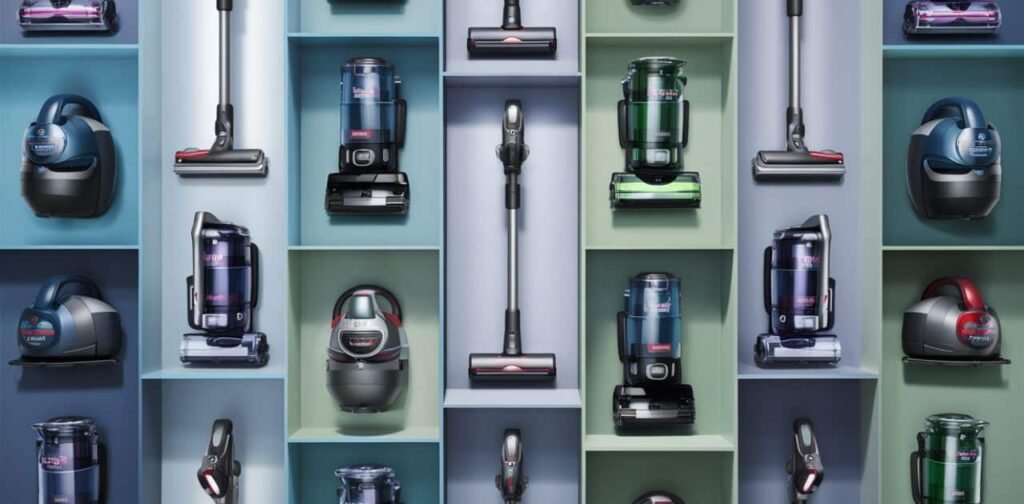
When it comes to versatility, Shark and Dyson are the vacuum cleaning equivalent of a Swiss Army knife. Between the two brands, you’ll find the perfect tool for virtually any cleaning scenario, from quick car vacuum jobs to deep-cleaning entire houses.
On the Shark side, their diverse armada includes:
- Upright Vacuums: Heavy-duty workhorses like the [Shark Rotator Professional][1], [Shark Rotator Powered Lift-Away TruePet][2], and [Shark Navigator Upright Vacuum][3] that dominate dirt on carpets.
- Handheld Vacuums: Portable powerhouses such as the [Shark WANDVAC][4] and [Shark Handheld Vacuum LV901][5] for conquering messes in cars, furniture, and tight spaces.
- Stick Vacuums: Lightweight yet mighty sticks like the [Shark IONFlex 2X DuoClean][6], [Shark Rocket DeluxePro][7], and [Shark Rocket Ultra-Light][8] built for whole-home cleanings.
- Cordless Vacuums: Utterly cord-free convenience with standouts like the [Shark Rocket Cordless][9], [Shark Rocket Pet Pro][10] and its self-cleaning brushroll, plus the [Shark ION F80][11] lightweight model.
Not to be outdone, Team Dyson brings an array of heavy-hitters to the fight, including:
- Their iconic Ball models like the [Dyson Light Ball Multi][12] and [Dyson Cinetic Big Ball][13] built for unbeatable maneuverability.
- The sleek and powerful [Dyson V11 Absolute][14] and [Dyson V10 Cyclone][15] cordless stick vacs.
- Portable options such as the [Dyson V8 Animal][16] cordless and [Dyson V6 Car & Boat][17] handheld.
- The pet hair-busting prowess of the [Dyson DC58 Animal][18] upright.
While Dyson offers a streamlined selection of high-quality models built for specific needs, Shark casts its net wider with a dizzying variety of choices within each vacuum category.
For those who value options galore to find the perfect fit, Shark’s versatility reigns king. But for discerning buyers who want a more curated, “Apple-esque” premium experience, Dyson’s focused lineup could hold more appeal.
Shark and Dyson Price Breakdown: Value vs. The Premium Experience
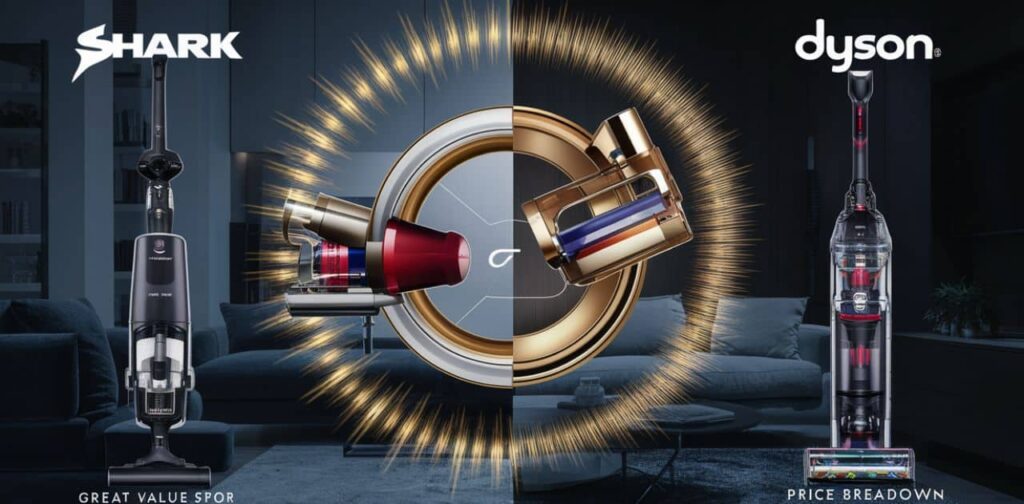
Let’s be honest for many folks, budget is the deciding factor when choosing between Shark and Dyson. While both offer top-notch cleaning performance, Dyson has solidified its reputation as the pricier, premium-tier vacuum option.
To give you an idea of the cost divide, let’s compare some popular models:
- The [Shark Vertex DuoClean][19] and [Dyson V11][14] cordless stick vacs have similar 50-minute runtimes and dust-bin capacities. But you’ll shell out around $375 for the Shark and a jaw-dropping $750+ for the Dyson.
- Comparing their powerful upright offerings, the [Shark Apex DuoClean][20] and the [Dyson Ball Animal 2][21] boast comparable specs and features. Aside from the signature Dyson Ball design, they’re virtual vacuum twins yet the Dyson commands upwards of a $125 premium at $500 compared to $375 for the Shark.
This price gap holds true across most Shark and Dyson model categories. You’re essentially paying a hefty premium for the Dyson brand name, iconic designs, and any marginal tech improvements they may offer.
But is that higher price tag justifiable for the average homeowner? That’s the million dollar (well, maybe $500) question. In terms of sheer cleaning power and features, Shark often holds its own while providing significantly better value.
That said, Dyson fans would argue the slight edge in suction power, filtration, and quality makes the luxury tax worthwhile for a best-in-class experience. Essentially, it comes down to personal priorities and budget constraints.
If you want advanced features and don’t mind paying a premium for the Dyson brand cache, go for it. But for a well-rounded, highly capable vacuum at a far more reasonable price point, Shark tends to be the more economical option for budget-conscious clean freaks.
Related Post:
Can You Mix Fabuloso And Bleach?
Battling the Dying Battery Blues
Charging Times:
- Charging times for both brands can be a slog, with some models taking up to 8 hours for a full juice-up. Yikes!
- Most Dyson cordless vacs hover in the 3.5 to 6 hours range. Not too shabby, but still a decent wait.
- Shark batteries tend to refuel a bit faster, with 2.5 to 4 hours being typical for a full charge.
Handling Battery Replacements:
- With Shark vacuums, you’ll likely need to replace the NiMH battery pack every 2-3 years depending on usage. Thankfully, replacement batteries are pretty affordable.
- Dyson’s Li-ion batteries last longer, around 3-4 years. But be prepared to pay a premium for replacements from Dyson down the line.
Overall, Dyson takes the crown for maximum battery stamina, especially with their top-tier V10/V11 models. But Shark delivers plenty of cordless run time for most average cleaning jobs while making up ground with lower battery costs.
The clincher is this: if you detest long charging delays and need all-day cordless freedom, Dyson’s superior battery life may justify its princely sums. For everyone else, Shark offers excellent cordless versatility while saving you from going broke on battery replacements.
The Dreaded Dust Bin Dilemma
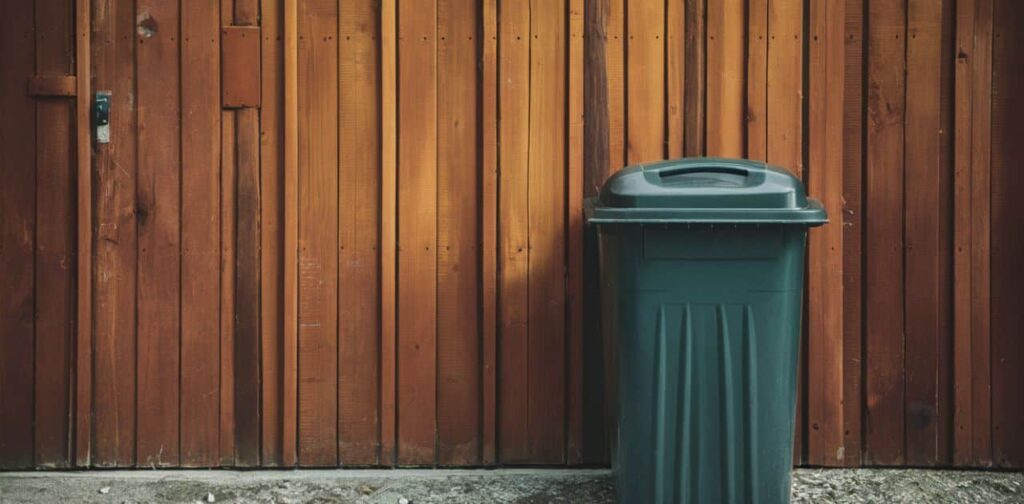
For as powerful as these cyclonic titans are at sucking up debris, all that dirt has to go somewhere eventually. That’s where their built-in dust bins come into play.
Both Shark and Dyson utilize brilliant bagless designs that ditch the hassle (and recurring costs) of vacuum bags. But when comparing their approaches to dust collection, some key differences emerge.
Size Matters
While dust bin capacity varies by model, in general Shark delivers larger bin volumes compared to similar Dyson units. Case in point: the Shark Vertex DuoClean rocks a roomy 1.5 dry quart capacity, while the mighty Dyson V11 maxes out at a measly 0.76 quarts.
Larger bins are a boon for those tackling heavy-duty cleaning projects without constant stops to empty the canister. Dyson’s focus on compact designs leads to more frequent bin clearing a minor annoyance if you hate interrupting your vacuuming groove.
Easy or Messy Bin Emptying
Dyson’s clear dust bins let you monitor fill levels precisely. But despite Dyson’s claim of “no more dust clouds,” many users report annoying dust puffing during emptying.
Shark employs a brilliant multi-layer filtration system that captures more fine particles as you empty the larger, easier-to-remove-and-rinse bins. Less mess, less stress.
With Dyson models, you’ll occasionally wrestle with pesky dirt clumps stubbornly clinging inside the bin, forcing you to go knuckle-deep in grime. An unpleasant experience pet owners dread thanks to tangled hair messes.
Speaking of pet hair, Shark pulls ahead with self-cleaning brushrolls that resist hair wrapping and tangling issues plaguing Dyson units. Simply brilliant for fur-baby feuds!
The Filtration Factor: Allergen Assassins
For allergy sufferers and those requiring clinical-level cleanliness, filtration capabilities could make or break your vacuum decision. Good news: both Shark and Dyson bring potent air filtering tech to the battle.
Dyson’s whole-machine HEPA filtration system is nothing to sneeze at (unless you have allergies). Their top-tier setups utilize a precise 5-layer filtration design capable of trapping a mind-boggling 99.97% of microscopic particles down to 0.3 microns from escaping back into your air.
Shark’s “Anti-Allergen Complete Seal” filtration hardly slouches either, capturing an impressive 99.9% of dust and allergens. And many Shark models offer optional HEPA filters for peak air-cleaning prowess too.
While Dyson tends to bake HEPA-caliber air filtration into all their premium units, Shark makes HEPA an extra-cost add-on for most of their lineup. So those with severe allergies may prefer Dyson’s more consistent extreme filtering across the board.
Upkeep Effort
Let’s not overlook the maintenance factor when it comes to keeping those filters in tip-top shape. Dyson utilizes washable pre-filters that capture larger particles before they can clog the main HEPA filter. A handy feature, but an extra step.
With Shark models, you’ll find a simpler filter situation with easy removal and rinsing of filters as needed. No tedious pre-filter cleaning required.
For the ultimate low-maintenance filtration experience conveying peace of mind, Shark’s straightforward yet potent allergen-sealing tech wins by a nose. Unless you’re an extreme asthma sufferer who can’t go without Dyson’s absolute pinnacle of HEPA air-purifying power at any cost.
Shark And dyson Weight Wars: Surviving the Upright Upheaval
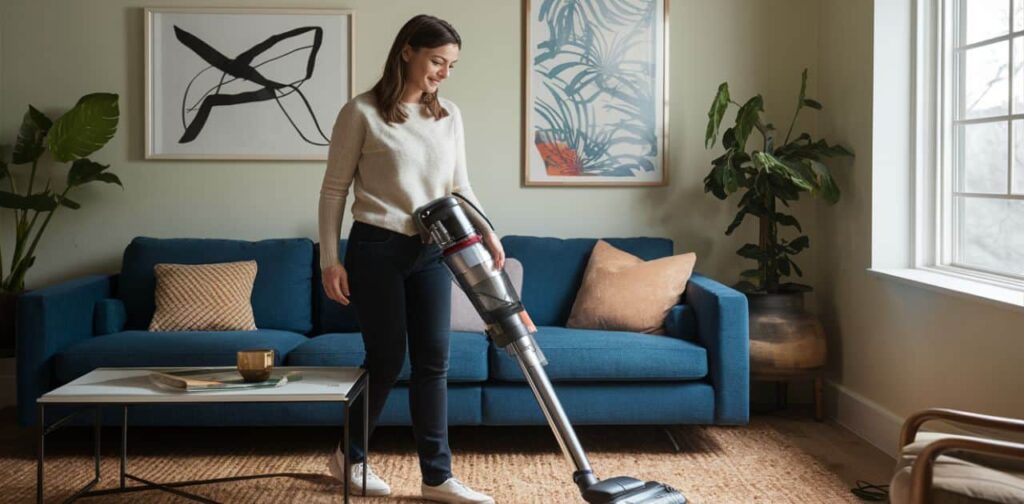
Ask any seasoned vacuum warrior about their biggest battlefield gripe, and you’ll hear one resounding grievance: heavy, unwieldy upright vacuums are a serious pain to lug around. The constant lifting, pushing, and maneuvering can leave you feeling more worn out than the floors you just cleaned.
Thankfully, Shark and Dyson have both tackled this issue head-on by engineering some impressively lightweight, easy-to-steer vacuum designs without sacrificing cleaning muscle. Even their full-sized upright offerings are a far cry from the clunky vacuum beasts of yesteryear.
Consider the ultra-maneuverable Dyson Ball models like the Multi Floor and Animal 2. Thanks to Dyson’s iconic ball-based design, you can effortlessly steer and pivot these upright vacuums around furniture using just a gentle twist of the wrist.
But the tradeoff? Weighing around 17-19 pounds (depending on the configuration), Dyson’s ball-powered uprights are a tad heavier than some comparable Shark models. Not a deal-breaker for most users, but those with mobility issues may notice the extra heft after extended vacuuming sessions.
Shark’s Lift-Away line brings wonderful portability solutions to their upright and stick vac families. The Rotator Professional and Powered Lift-Away uprights weigh in at a relatively lightweight 15 pounds yet can detach into a canister mode for easier carrying up stairs or cleaning hard-to-reach areas.
Shark’s full-size stick vacs like the Rocket series punch even harder in the portability department. The versatile Rocket Ultra-Light and DuoClean PowerFins weigh as little as 7-9 pounds while delivering all-surface cleaning excellence.
The true lightweights, however, are Shark’s dedicated handheld and cordless stick vac lineups. Petite yet potent models like the Shark WANDVAC, Rocket Pet Pro, and ION F80 all keep the scale hovering below an effortless 4 pounds. Perfect for those “quick mustard packets under the car seat” situations.
Dyson brings the heat with agile stick vac options too, from the brawny yet 6-pound Dyson V8 cordless to the 3-pound featherweight Dyson V6. But when it comes to the extremely lightweight, perfectly portable category, Shark establishes itself as the undisputed reigning champion.
For whole-home deep cleaning endurance while minimizing back strain, Shark’s diverse array of lighter-than-air vacuums steal the show. Dyson’s full-sized offerings deliver on maneuverability but don’t stray too far into true featherweight territory. Choose your wright-for-the-fight wisely!
Winning the War on Noisy Neighbors
Based on extensive decibel testing and real-world user experiences, Shark earns top marks for hushed vacuuming across most of their lineup. Their brushroll design reduces that trademark high-pitched whine, with most full-sized models clocking in at a relatively peaceful 70-75 decibels.
Quieter than a dishwasher or bathroom exhaust fan, these Shark sound levels allow you to clean without decimating your eardrums or prompting noise complaints.
Dyson, while incredibly powerful, tends to produce more noticeable volume during operation. Their cyclonic models frequently top out at 75-80 decibels, about the same as a garbage disposal running. Not deafening by any means, but enough to raise eyebrows among lighter sleepers.
The loudest offenders in Dyson’s squad? Their trigger-operated handheld and cordless stick vac variants. Dyson’s miniature motors must work overtime on these compact units, resulting in pitched whines hitting the 80-85 decibel range when you hammer the power trigger. Enough to make dogs howl (but great for waking up teens!).
Of course, these are just general guidelines. The acoustics of your home and surfaces being cleaned can impact perceived vacuum noise levels too. But all things equal, Shark simply produces quieter cleaning experiences across the board.
For peaceful morning tidy-ups, midnight pet hair battles, or anytime you need to fly under the noise radar, Team Shark’s penchant for muffled operation gives them the quiet advantage.
Double Brush Dazzlers or Suction Powerhouses?

At the end of the day, the most crucial vacuum metric comes down to one make-or-break question: just how flawlessly can these bad boys remove stubborn dirt, dust, and debris from every exposed surface?
When it comes to sheer brute-force suction power, the Dyson team flexes some serious muscle. Iconic Dyson models like the V10, V11, and Ball Animal 2 rate among the most powerful vacuums on the market in terms of airflow and air pressure. Figures that consistently blow (pun absolutely intended) competing models out of the water.
Dyson’s impeccably designed cyclones and airflow chambers enable them to maintain impressively consistent suction over longer periods, resist clogging better, and make short work of floor debris. Pet owners will also appreciate Dyson’s prowess against embedded fur and dander.
However, as many vacuum veterans know, overwhelming suction isn’t everything. Sure, it helps dislodge and transfer grime but only if your brushroll can actually agitate it off surfaces first. And this is where Shark’s acclaimed “DuoClean” double brushroll design gives Dyson’s suction supremacy a run for its money.
While Dyson vacuums rely on conventional bristle brushrolls, Shark’s dual brushroll system deploys a bristle roll to dig into carpets and a separate soft roller to pull larger debris off hard floors and area rugs. The result? Nothing escapes the grabbing grip of those twin brushes, regardless of surface type.
In addition to pulling in larger messes like cereal spills, the soft brushroll excels at removing finer dust and particles kicked up into the air by the bristle roller. It’s a beautifully choreographed one-two punch of cleaning prowess.
This combo action earns Shark top honors in hairball removal too. Shark’s brushrolls efficiently suck up pet hair without leaving tangled mats of fur wrapped around the rollers an infuriating issue dogging many Dyson users.
Dyson owners must endure tedious brushroll detangling, a hassle the self-cleaning Shark brushrolls avoid thanks to their ingenious debris channeling. While both brands muscle through most dry messes, Shark takes the edge for homes battling shed fur and frequent spills.
So which cleaning strategy reigns supreme: Dyson’s astonishing suction power or Shark’s twin brushroll brilliance? Like any great vacuum brand battle, the answer depends on your unique cleaning scenarios.
If you prize out-of-this-world lift for carpets laden with deeply embedded dirt and pet hair, Dyson’s ferocious cyclonic abilities could have the edge. But for homes with frequent dry debris disasters like crisp scatters and pet hair tumbleweeds on any given floor type, Shark’s double brushroll design is the ultimate cleaning champ.
At the end of the day, both extreme suction and optimized brushing play pivotal roles in peak cleaning performance. These vacuum icons simply take slightly divergent yet still highly effective paths toward the same sparkling objective.
The Final Verdict: And the Vacuum Victor Is

After scrutinizing every spec, feature, and real-world performance factor, we’ve reached the ultimate conclusion in the timeless Shark vs Dyson vacuum showdown.
But before we crown an overall champion, let’s quickly recap where each brand reigned supreme:
Shark’s Vital Victories:
- More budget-friendly pricing across the board
- Wide variety of models/styles to choose from
- Larger dust bin capacities that don’t require frequent emptying
- Self-cleaning brushrolls that avoid hair wrap nightmares
- Quieter cleaning operation
- Lighter weight and increased portability
- Easier to remove/rinse bins and filters
Dyson’s Dominating Highlights:
- Superior battery runtimes on flagship cordless models
- More consistent HEPA filtration on premium vacuums
- Innovative ball tech for unbeatable maneuverability
- Slightly stronger suction power on carpets
- More advanced quality-of-life features and displays
- Unmatched brand prestige in the vacuum world
As you can see, both of these vacuum titans have their respective strengths which makes the “better brand” distinction heavily dependent on your specific cleaning needs and priorities.
If you value cutting-edge features, elite maneuverability, potent carpet suction, and prestige branding enough to invest in a premium-priced Dyson, you’ll be rewarded with one of the most powerful, intelligently designed vacuums money can buy.
However, if factors like quieter operation, lighter weight, pet hair conquering, and sheer value-per-dollar sit higher on your checklist, then the versatile, budget-friendly brilliance of Shark vacuums is incredibly tough to beat.
For the average household, Shark simply delivers equally capable (if not slightly better) cleaning performance across all surfaces with fewer haircuts and dust bunnies surviving the onslaught of its twin-brush juggernaut of a system.
Don’t get us wrong Dyson’s elite suction tech still reigns supreme for extracting the most stubbornly embedded debris from plush carpets and crevices. Their air filtration also remains the gold standard for asthma and allergy sufferers. But overall, Shark punches well above its weight class in more day-to-day cleaning scenarios.
So while Dyson’s prestigious brand cache and premium models will always attract luxury buyers, in the immortal words of Shark Tank’s Kevin O’Leary, Shark has officially become “the best bang for your buck” amongst the vacuum cleaning masses. Their combination of exceptional cleaning power, diverse feature set, and unbeatable value solidifies them as our overall vacuum champion over Dyson.
Recommended Post:
Is It Safe To Mix Baking Soda And Bleach?

Howdy is behind this home blog, sharing personal stories, thoughts, and insights from daily life. I can dedicated to bringing you the latest trends, expert advice, and creative ideas to make your home the sanctuary you’ve always dreamed of. Whether you’re looking for DIY tips, home decor inspiration, home loans, rentals or renovations.

